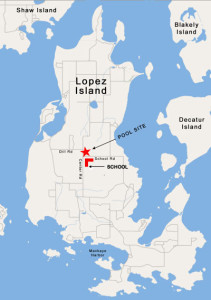by Claire Anderson | Mar 31, 2025 | News
Lopez Island, WA | March 21, 2025
LOPEZ SWIM CENTER DIRECTOR
Job Description
Organization: Lopez Swim Center | Friends of Lopez Island Pool (FLIP)
Location: Lopez Island, Washington
Reports to: FLIP Board of Directors
Position Type: Full-time
Salary Range: $75,000-$85,000; commensurate with experience
OVERVIEW: FLIP seeks a dynamic, visionary aquatic professional with entrepreneurial and leadership skills to oversee the Lopez Swim Center from final stages of construction through full operations and ongoing success. The Swim Center Director will play a pivotal role as the top management position and will provide strategic direction, daily operational oversight of a $1 million annual operating budget, and manage staffing, finances, and facility maintenance to ensure a safe, inclusive, positive and enriching experience for our community.
Lopez Island is located within the San Juan Islands, a premier tourist destination in Washington State, known for its natural beauty and mild climate. Referred to as the “friendly island,” Lopez Island is often described as a welcoming community that attracts nature lovers, artists, and outdoor enthusiasts with its rural charm and laid-back atmosphere. Activities like biking, kayaking, golf, fishing and beachcombing are enjoyed year-round. Accessible by ferry or small plane 1.5 hours north of Seattle, the Lopez Swim Center will serve Lopez residents, a large second-home population, neighboring islanders, and over 80,000 summer tourists.
Friends of Lopez Island Pool (FLIP), a community-focused nonprofit, is privately funding the building of the Lopez Swim Center and will own and operate the facility as a membership model while also open to the public, without tax support. Construction is underway, with a planned November 2025 opening. Visit www.lopezislandpool.org for details.
The Lopez Swim Center, with strong community support, will be the only all-ages, year-round aquatic recreational facility on Lopez Island. The Center will have two pools, a 4-lane 25-yard lap pool and a warm-water program and activity pool. The pools transition from outdoors in the summer to indoors with an air-supported dome during cooler seasons. The facility includes indoor and outdoor spaces for community events and activities.
SWIM CENTER OPERATIONS & LEADERSHIP
- Oversee Lopez Swim Center operations and build and grow a culture of excellence, providing strategic leadership and daily operational oversight.
- Drive growth by leading the Swim Center with visionary strategies, curating a comprehensive portfolio of programs
- Drive revenue by creating a sustainable revenue stream through programming, membership, and by building community and programming relationships to generate rental income
- Ensure operational efficiency; establish and implement operational policies and procedures
FINANCIAL MANAGEMENT & OVERSIGHT
- Develop and manage the annual and long-term budgets with full responsibility for optimizing resources and driving profitability while maintaining service excellence
- Ensure fiscal responsibility and sustainability
- Monitor revenue and expenses, analyze financial performance, and implement strategies for improvement.
- Oversee purchasing and inventory management ensuring cost-effectiveness and appropriate resource allocation.
MEMBERSHIP AND PUBLIC USE
- Work closely with FLIP Board and community engagement and marketing team to set membership and user goals and driving membership and use to achieve these goals.
- Develop strong relationships with members and users, fostering direct communication and maximizing participation in aquatics programs.
- Member experience optimization: Ensure desk staff are fully knowledgeable about program schedules, events, and any changes, delivering a seamless experience to all members and daily users.
- Oversee membership and daily use programs to ensure an exceptional experience for all
- Manage membership and program registration systems and Financial Assistance program
STAFF MANAGEMENT
- Recruit, train, and mentor a high-performing aquatics team, overseeing continuous staff development through in-services and training
- Create and implement staff job descriptions, compensation guidelines, policies, and performance reviews.
- Foster a positive and collaborative work environment that promotes teamwork and professional development. Maintain consistent communication with aquatics staff, involving them in program and member engagement.
- Manage and collaborate with Swim Center service providers such as accounting firm and consultants as necessary.
PROGRAM DEVELOPMENT & MANAGEMENT
- Oversee the development, implementation, and evaluation of a diverse range of aquatic programs, including swim lessons, water fitness classes, competitive swimming, and recreational activities.
- Assess community needs and trends to identify opportunities for new program development and enhancements.
- Ensure program quality and effectiveness through regular evaluation and feedback mechanisms.
- Manage program registration and scheduling, maximizing participation and revenue generation.
- Develop and manage outside user rental and usage agreements
FACILITY & RISK MANAGEMENT
- Manage and mitigate risk, ensuring the safety and well-being of all patrons and staff
- Develop and conduct Swim Center management, operational, emergency, and safety procedures, manuals, and action plans
- Oversee Swim Center maintenance and perform regular and light maintenance upkeep ensuring a clean, safe, and functional environment.
- Manage facility scheduling and usage, maximizing utilization and minimizing disruptions.
- Coordinate with contractors and vendors for repairs, maintenance, and capital improvements.
- Ensure compliance with all relevant safety regulations and codes.
COMMUNITY ENGAGEMENT/MARKETING/ FUNDRAISING
- Support staff and board initiatives to develop and maintain strong relationships with community partners, stakeholders, and potential sponsors.
- Foster a welcoming and inclusive environment for all members of the community.
QUALIFICATIONS
- Bachelor’s degree in recreation management, sports management, or a related field preferred or equivalent training and experience
- Proven experience in managing aquatic or recreational facilities and aquatic programs.
- Strong leadership, management, and interpersonal skills.
- Excellent communication, organizational, and problem-solving skills
- Experience with pool mechanical and operating systems
- Demonstrated ability to develop and manage budgets.
- Knowledge of aquatics, safety and risk management practices.
- Certifications and renewals can be obtained once hired in CPR, First Aid, and Lifeguarding (Instructor certifications a plus).
- Passion for aquatics and community service.
JOB DETAILS
- Full-time salaried position
- Position to start in late spring or early summer
- Hours are flexible, often requiring weekends and evenings based upon job requirements
- Requires physical ability and stamina to perform the essential functions of the position.
BENEFITS
- Two-weeks of paid vacation/year beginning after six months of employment, opportunity to increase after year two
- Health insurance stipend
- Participation in Swim Center performance-based management bonus pool
- Assistance in finding and securing housing on Lopez Island
APPLICATION PROCESS
- Please include the following in your application: Cover Letter, Resume, References
- Apply by May 1, 2025
- Please send applications by email to:Stu Isaac, Interim Swim Center Director and Aquatic Advisor; Email: stu@isaacsportsgroup.com
- For questions and additional information requests: Please email Stu Isaac
by Claire Anderson | Feb 5, 2025 | News
February 4, 2025
Lopez pool to open this year; local school kids to benefit
NANCY DEVAUX of the Salish Current
The Lopez Island Public School community made a splash on Jan. 21 in support of the much-anticipated Lopez Swim Center, now under construction on Pool Lane and slated to open later this year.
The swim center is privately owned by the nonprofit Friends of Lopez Pool (FLIP), but it will provide opportunities for public use, including residents from other islands. About 250 students from the Lopez Island School District (LISD) will be given scheduling priority during school hours.
“Our partnership with the Lopez Swim Center is driven by our shared goal that every student will graduate knowing how to swim” said Martha Martin, Lopez school district K–12 principal.
A major impetus for building a pool on the island was that 90% of Lopez school students aren’t able to swim, according to FLIP’s website. San Juan County is one of only two counties in the state without a public or school district pool.
MORE: Read the full article here,
by Claire Anderson | Feb 4, 2025 | News
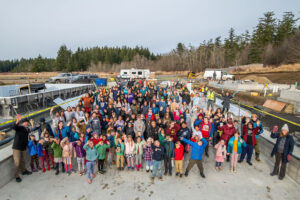
Click on the photo above to see the Lopez SPLASH MOB in action!
Exciting news! A total of $786,000 was put into the Governor’s proposed capital budget to support completion of the Lopez Swim Center, but our District 40 legislators and State budget chairs need to hear from YOU to ensure the funding is approved.
The proposed funds include a $523,000 local and community projects direct appropriation and a grant of $263,000 from the 2025-2027 Youth Recreational Facilities program.
YOUR voice matters! Please take two minutes today to write a heartfelt e-mail explaining why supporting the Lopez Swim Center is important for our community.
Having writer’s block? No worries—we’ve included several sample messages below to cut, paste, and customize (if you want)!
To make it easy, email to director@lopezislandpool.org and we will forward your message
— OR —
For more impact, EMAIL DIRECTLY by copying and pasting these email addresses into your email: Liz.Lovelett@leg.wa.gov, Alex.Ramel@leg.wa.gov, Debra.Lekanoff@leg.wa.gov, Steve.Tharinger@leg.wa.gov, Yasmin.Trudeau@leg.wa.gov, director@lopezislandpool.org
Together, we can secure these vital funds for Lopez Swim Center and foster a healthier future for our island community.
SAMPLE MESSAGES:
Subject: Please Support the Lopez Swim Center!
I am writing to express my heartfelt support for the Lopez Swim Center and urge you to support the proposed funding of $786,000 in the Governor’s budget to help complete the Lopez Swim Center, which is currently under construction. With your support, it’s expected to open in late this year!
The Swim Center fulfills a vital public-safety role on our island, where only 8% of Lopez elementary students passed the basic Red Cross Swim test. San Juan County is one of only two counties in Washington without a public or school pool.
The Swim Center will also provide a year-round place for our community’s many seniors, with warm water helping mobility, fitness, and recovery from injuries. It will be an essential community hub.
I urge you to consider the significant impacts the Swim Center will have on our community and to strongly support its funding.
Sincerely,
[Your Name & Location]
This is such an exciting time for children who live on Lopez Island—and all its residents! After years of work and successful fundraising, the Lopez Swim Center has reached the construction stage. We know that the many carefully planned programs in the Center’s two pools, including school PE, swim lessons, aquatic fitness and physical therapy, plus water safety and lifeguard training, will soon be a reality.
This is a time for dreams to come true, but it is also a time of urgency to complete fundraising in step with the Center’s final construction. We urge you to support the Governor’s recommendation in the capital budget so we can complete this important project that will transform the community. Thank you for your past significant work and support for the Lopez Swim Center!
Sincerely,
[Your Name & Location]
I am delighted to report that the Lopez Swim Center, a community project, is now fully under construction! Everyone on Lopez is grateful for the past support and interest shown by you and your fellow legislators. The cheers thrown up last week and pool noodles waved by more than 125 Lopez School District students who crowded into the largest pool were meant for you, too!
This is a wonderful cause for celebration, but also cause for urgency to complete fundraising in step with the final phase of construction. Everyone on Lopez—young and old, active and infirm, well off and struggling—urges you to support former Governor Inslee’s recommendation in the Capital Budget for an allocation for the Lopez Swim Center. This project is transforming our island community by building a year-round, all-ages, all-abilities community facility for fitness, learning, and healing.
Sincerely,
[Your Name & Location]
In the entire state of Washington, San Juan County is one of only two counties without a public or school pool. Not surprisingly, 92% of elementary-aged children on Lopez Island are unable to pass a Red Cross swimming test. By constructing a community Swim Center, Friends of Lopez Island Pool (FLIP) is looking to reverse that trend. The Lopez Swim Center is currently under construction and slated to open late this year. However, we need your support of the Governor’s capital funding request submitted for this year’s budget for us to achieve this goal.
I would greatly appreciate your support of this funding for the Lopez Swim Center.
Sincerely,
[Your Name & Location]
First, I want to thank you for your past support to help us build the Lopez Swim Center, a crucial community resource that will have significant impacts on the lives of islanders, both young and old. Currently, it’s estimated that 92% of Lopez elementary-aged students cannot pass a basic Red Cross swim test. The Swim Center will help turn this tide, with the goal of every child learning to swim by graduation! A large segment of our population is over age 60, and the Swim Center will also play a vital role for improving the health and wellness of many island seniors, whether that’s through aquatic aerobics classes, aqua physical therapy, or lap swimming. We’re asking you to approve the funding request in the current proposed budget to help us close the funding gap and complete the Swim Center.
Sincerely,
[Your Name & Location]
Construction has started on our Lopez Swim Center, an essential year-round, all-ages, all-abilities community hub fostering water safety, wellness, fun, and fitness. While we hope to have construction completed by the end of this year, that will only be possible with your help. We strongly urge you to approve the capital budget recommendation for the Lopez Swim Center.
Sincerely,
[Your Name & Location]
After 15 years of planning and fundraising, construction of the Lopez Swim Center is finally underway. The goal is to complete the pool facility by the end of this year. But while we’re continuing our fundraising, we need your help to help close the gap.
Every county in the state of Washington has a community pool—except for San Juan County and one other. This lack is even more significant given the fact that 92% of Lopez Island elementary students are unable to pass a basic Red Cross swimming test. The Lopez Swim Center’s mission is to turn this tide, with the goal of every Lopez child learning crucial, life-saving swimming and water-safety skills. The year-round Swim Center will benefit islanders of all ages and all abilities, offering a safe haven for fitness, fun, and friends. For the health and wellness of San Juan County islanders, I’m asking you to put your support behind this capital funding recommendation.
Thank you!
Sincerely,
[Your Name & Location]
by Claire Anderson | Dec 28, 2024 | News
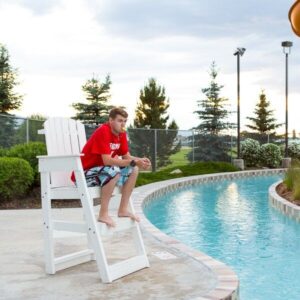
Coming soon to the pools near you: lifeguards—and lifeguard chairs!—at the Lopez Swim Center! Thanks to a generous 2024 grant from the Lopez Thrift Shop, two Mendota portable lifeguard chairs were purchased and are in storage, waiting for the Center’s opening day in late 2025. These weather-resistant chairs will offer perches for our swim-safety specialists to keep a lookout—and make sure everyone in the pools are staying safe while having fun!
We greatly appreciate the Lopez Thrift Shop’s continued support!
by Claire Anderson | Dec 27, 2024 | News
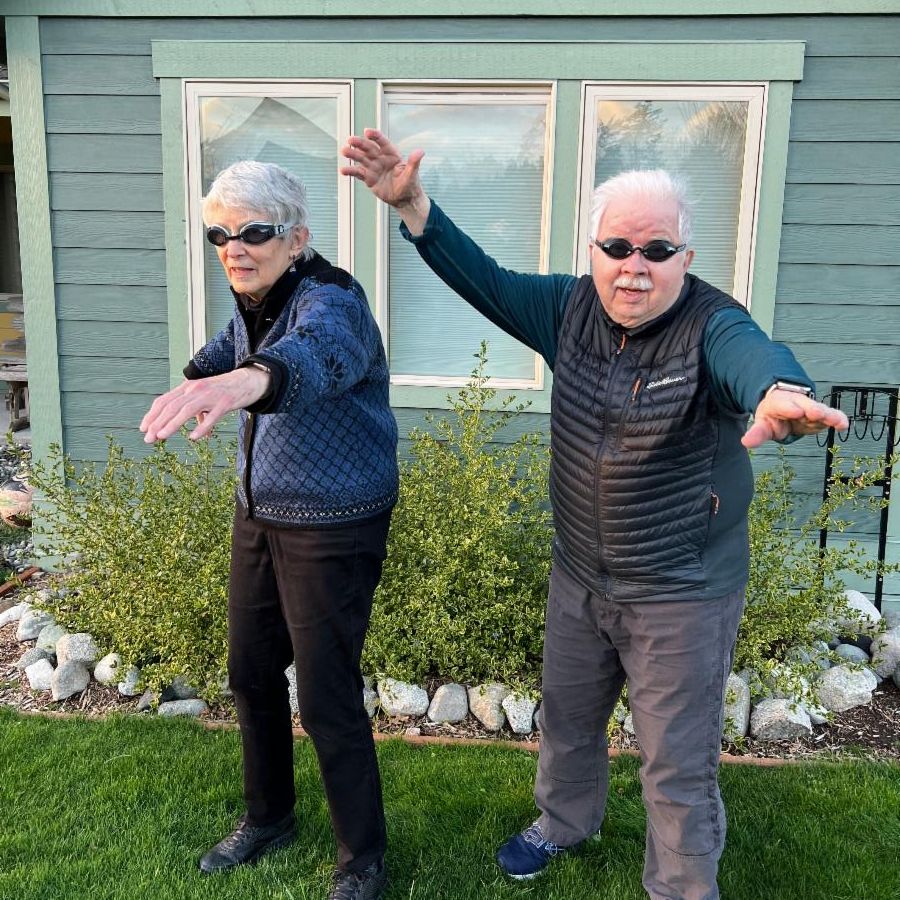
Longtime FLIP donors Diana and Ed Sheridan are ready to JUMP IN when the Lopez Swim Center opens its doors in late 2025. Here’s what Ed recently wrote to FLIP:
“Let me get my swimming trunks!! I’m 86 and I love to swim on Cape Cod or soon, on Lopez Island.
I am enthusiastic about our new pool, and I’m proud that my wife and I were able to contribute to the costs for planning and designing it.
Our new pool will be a gift for all of the San Juan Islands. It will appeal to older folks like me, and also to the folks who are introducing their children to the warm waters of our first-class pool.
When you hear the whistle, then it’s time to jump into the water!”
by Claire Anderson | Dec 3, 2024 | News
|
The Lopez Swim Center is under construction on Pool Lane. The pools’ excavation is finished, with construction of the mechanical building coming next. Watch as progress continues on Pool Lane!
And don’t miss your chance to double your impact NOW: Your year-end donations help fund completion of the Swim Center.
More than 1,300 donors have joined already, and we‘ll be even stronger with your support. TAKE THE PLUNGE! DONATE TODAY to reach our $250,000 year-end goal! |
|
|
To kick off this year-end fundraiser, Lopezians Leslie Quenell and Brian Silverstein will match all gifts received, up to $5,000!
This local dynamic duo has been supporting the idea of having a local swim center for years. “Our daughter started taking swimming lessons in public pools at age 4, when we lived in Portland,” says Brian, “so we understand the importance of helping kids get these skills from an early age. Here on Lopez, we are concerned about how few local island kids have basic swimming skills.”
“What we want for all Islanders is year-round, easy access to pools for fitness, water safety, and fun,” says Leslie. “There is no better time to join FLIP. We want to get the pools done so we can swim. Please join us!” |
|
|
|
Aqua Therapy at the Swim Center Provides New Hope for Healing
In partnership with Lopez Island Physical Therapy (LIPT), the Lopez Swim Center will offer a new path on the island to recover from injury or deal with chronic pain: aqua therapy.
The Center’s 24-by-38 warm-water wellness pool will be the site for this highly effective type of physical therapy.
Lopezian Scott Allred, board-certified specialist in orthopedic physical therapy and owner of LIPT, is excited to offer this unique service to the island community. He believes it will make a big difference for islanders who could benefit from an alternative to treatment in a traditional clinic setting.
“Aqua therapy facilitates many of the modalities we do in physical therapy—stretching, strengthening, relieving pain—but in a gentler way,” says Allred. “It gives you a ton of pain-relieving options to perform exercises.”
What makes aqua therapy so great?
- Less pain, more gain: Water makes you more buoyant and movement easier, reducing stress on your joints and muscles.
- Build strength, gently: The water’s resistance helps you get stronger without straining your body.
- Relax and heal: The warm water can help soothe your muscles and improve blood flow, improving mobility.
Aqua therapy can help people of all ages with a variety of conditions, such as:
- Sports injuries
- Arthritis
- Back pain
- Neurological conditions (like multiple sclerosis or Parkinson’s)
“Aqua therapy allows people to perform exercises in a way that is less painful and has less impact on the body,” says Allred. “Most physical therapy clinics don’t provide aqua therapy because it requires access to a pool and specialized training; it’s not common,” he says. “I’m excited to offer it here on Lopez.”
If you think you might benefit from aqua therapy, Allred recommends seeking a physical therapy referral from your primary care provider.
“We’re looking forward to using this as another way to treat islanders and help them resume the activities they want to do again. Aqua therapy provides a great alternative for people.” |
|
| Scott Allred, DPT and owner of Lopez Island Physical Therapy, with his wife Adriane, their children Hugo and Andie, and goldendoodle Wally. |
|
|
by Claire Anderson | Sep 24, 2024 | News
As the weeks unfold and summer has turned to fall, there’s been plenty of activity on Pool Lane to get YOUR SWIM CENTER built! Crews have been busy with site work these past few weeks, and the spaces for the two pools have been excavated, with concrete work to follow.
Stay tuned as this project unfolds, and follow YOUR POOL’S PROGRESS here, as well as on Facebook and Instagram.
by Claire Anderson | Sep 1, 2024 | News
FOR IMMEDIATE RELEASE | August 2024
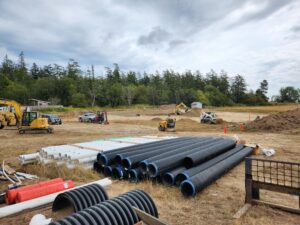
Construction Begins on Lopez Swim Center; Local Contractors Chosen for Project
The long-awaited construction of the Lopez Swim Center, located on 2.5 acres just off Center Road, is officially underway, marking a significant milestone for islanders. With two pools—one four-lane lap pool and one warmer-water wellness pool—the Center promises to be a beacon of health, wellness, and recreation for residents and visitors of all ages.
Friends of Lopez Island Pool (FLIP) board and committee members were on hand for the first shovel in the ground. Plans are underway for a community event to celebrate this milestone moment later this fall.
Sage Building Solutions, owned by longtime Lopezians Jenny and Doug Poole, is the general contractor for the project. They bring their expertise and commitment along with Donnie Poole as site superintendent. Other local contractors are involved: MR Buffum of Lopez Sand & Gravel is currently doing excavation and site work; local architects Lois and Bob Wardell of Wardell Architects are helping shepherd the project; and Tom Froning of Lopez-based design-build firm Soundesign is FLIP’s Owner’s Representative.
“There has been a tremendous response by local contractors to help bring this long-awaited vision to reality,” says Executive Director Anne Marie MacPherson, “and to do so in the most cost-effective way possible.”
Construction kicked off with site mobilization and preparation during the first week of August. Utilities are getting placed and, once site grading is complete, excavation for the two pools will begin. The steel-framed Myrtha pools purchased earlier this year are already in storage on-site.
Construction is expected to take about 12 months, with the Swim Center slated to open in Fall 2025. Final fundraising efforts will run synchronously with the construction project to complete the capital campaign.
The Swim Center will be a year-round place for the community and visitors alike to come together for fun, fitness, and healing. From community gatherings to outdoor BBQs on the lawn; to exercise classes and physical therapy; from lap swimming to camps and family Dive-In Movie nights, the Swim Center will have something to offer everyone. In the summer, the pools will be open-air, so that swimmers can bask in the sunshine. In the winter, the pools will be enclosed within a heated, air-supported structure, which offers significant cost-savings upfront compared to a conventionally built natatorium.
Operating as a nonprofit, the Swim Center will be open to the public but will not rely upon property tax monies or levies. Instead, user fees (including memberships, drop-in and weekly passes), fitness class and training fees, summer and winter camp tuition, and special event and facility rentals will support the Center’s financial viability, now and in the future. Scholarships, sponsorships, and discounted memberships will ensure all who want to swim can join the fun. (For more details on proposed membership tiers, visit FLIP’s website.)
The Center is currently recruiting skilled swimmers, aged 15 and up, to participate in lifeguard certification training in preparation for paid positions as lifeguards, junior lifeguards, and swimming instructors. The first informational meeting this fall will be on Tuesday, Sept. 10, from 5:00 to 6:00 p.m. in the Lopez Library’s meeting room.
As operations unfold, FLIP is looking for more community members to join the inaugural crew and help with events and prepare for opening day! Visit www.lopezislandpool.org/volunteer.
by Claire Anderson | Aug 16, 2024 | News
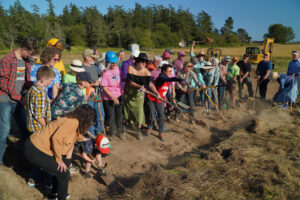
Board and Committee members were on hand for the first shovel in the ground (see video below) and we invite the ENTIRE community to celebrate this milestone moment this fall! Look for announcements coming soon
!
by Claire Anderson | Feb 22, 2024 | News
The Dream Has Arrived:
THE POOLS ARE HERE!
The two Myrtha pools arrived on Lopez on January 30th and are in storage on Pool Lane.
We are eagerly anticipating the culmination of the construction campaign to close the gap in fundraising. We’re almost there, and getting closer every day, thanks to your ongoing support. The Islands will Swim!
___________________________________________________________________
 Winter Appeal Brings in More Than $720K!
Winter Appeal Brings in More Than $720K!
We are thrilled to announce that our 2023 Winter Appeal was a tremendous success, raising $723,154.35! We would like to express our sincere gratitude to all of our donors who generously contributed to this important fundraising effort. Thanks to your support, we are getting closer to construction. We truly could not have done it without you. You are making the dream come alive!
P.S. Did you donate to FLIP in 2023? If you’d like a duplicate report of your tax-deductible giving, we can help! Please contact info@lopezislandpool.org.
___________________________________________________________________
“Pool Progress: Behind the Scenes of the Lopez Swim Center” is an eight-part informational series about the Lopez Swim Center. These articles are possible thanks to a Lopez Thrift Shop grant. This is part five of the series: FLIP interviews Stu Isaac of Isaac Sports Group, FLIP’s Aquatic Advisor.
Financial Sustainability & Membership at the Lopez Swim Center
FLIP: How did you approach this project?
Our first steps were to understand the unique elements of Lopez Island and how they impact the Swim Center’s development and operation. We viewed this through the lens of best practices that apply to all aquatic facilities, as well as our extensive research on Puget Sound area swim facilities.
What is the Center’s model for operating and how will it be affordable to all?
FLIP is a nonprofit business, combining the best of public and private swimming models. Similar to any business, it needs to be financially sustainable, but as a nonprofit, it also must be affordable to all. A financial assistance program was established to provide discounts of 50%, 75%, and, in special cases, 90%. This was one of the most important outcomes of our business planning.
The Center will not rely on levies or taxes for funding. Instead, it relies upon user fees and pool passes, which make up 65% of overall revenue. The estimates of pool-pass sales is also conservative, with Year One projections at only 68% of projected full use by Year Three.
Summer-season prices will reflect peak demand, and allow annual and monthly pool-pass prices to be kept low for the nonpeak season (eight months of the year). We strongly feel the pool-pass projections are very conservative. These projections assume that, by Year Two, only 14% of Lopez families with children under 18 will have an annual Swim Center family pool pass. The market penetration for seniors is even lower, with our senior annual pool-pass projections showing only 9% of Lopez seniors having passes. We estimate adult-specific annual pool-pass sales to only 10% of adult residents. Overall, we project that 19% of Lopez year-round residents will have some type of monthly or annual pool pass at the Swim Center.
Having two pools offers the ability for concurrent programming, providing more opportunities for fun and significantly bolstering the Center’s financial sustainability. A wide range of programs, such as swimming lessons, special events (birthday parties or sunset gatherings at the pool), facility rentals, and a variety of classes, will generate an additional 31% of gross revenue, with only 4% of the total revenue coming from annual fundraising. |
|
…I am now very confident in the financial viability and the budget projections for the Swim Center—and in the incredible game-changer the Center will be in the overall quality of life for all Lopez Island residents.
—Stu Isaac, FLIP Aquatic Advisor
|
Pools are expensive to run; how is this any different?
Expense projections were based on best-practice operations to keep the Swim Center safely operating for years to come. We worked closely with Water Technology Inc. (WTI), the project’s aquatic engineers, to identify key technologies that reduce maintenance costs, as well as energy, water, and chemical use. The operational savings pay for the incremental cost of the technology in the first two to three years of the Center’s operation; the return on investment over the long term is very good. Utility costs constitute less than 10% of total operating costs, which is also excellent. Staffing costs make up 60% of total operating costs, which is right in line with best-practice aquatic facilities around the country.The Center has made strategic decisions to limit costs. For example, instead of having a permanent water slide, FLIP will rotate flexible activities, from inflatable obstacle courses to pool log-rolling, which collectively cost just 20% of what a water slide would cost and do not require additional assigned lifeguards at the top and bottom of the water slide. Rotating activities keep programs fresh so that people want to come back. We feel that the expense model for the Swim Center is realistic and conservative.
What about long-term maintenance and equipment replacement?
FLIP secured an initial donor commitment of $510,000 to seed its Capital Reserve Fund (CRF). Our budget projections predict net annual revenue beginning in Year 3, which will allow the Center to allocate funds to the CRF over subsequent years, accruing $1.85M by Year 20. Besides the CRF, the Center’s budget provides best-practice maintenance funding to meet all equipment maintenance requirements and recommendations to limit unexpected capital maintenance needs.
What provides some assurance of the Center’s financial sustainability?
We worked with a bottom-up approach and only consolidated revenue and expense totals at the very end, without targeting specific financial results. This approach ensures the accuracy of our projection, and gives both FLIP and us strong confidence in the validity of the operating budget. Over the course of our research, program design, and development of the business model, I am now very confident in the financial viability and the budget projections for the Swim Center—and in the incredible game-changer the Center will be in the overall quality of life for all Lopez Island residents. |
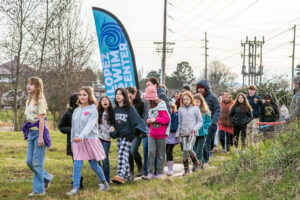













 Winter Appeal Brings in More Than $720K!
Winter Appeal Brings in More Than $720K!
